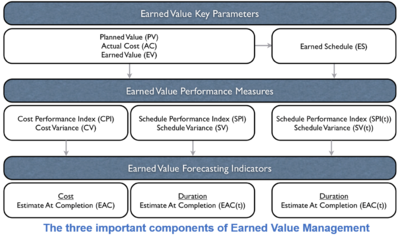Earned Value Management (EVM)
Earned value management (EVM), earned value project management, or earned value performance management (EVPM) is a project management technique for measuring project performance and progress in an objective manner.[1]
Background and Objectives of Earned Value Management[2]
The concept of earned value management became a fundamental approach to program management (EVM project management) in 1966 when the United States Air Force mandated earned value (USAF EVMS) in conjunction with the other planning and controlling requirements on Air Force programs. The requirement was entitled, the Cost/Schedule Planning Control Specification (C/SPCS). Over the decades, the concept and its requirements have remained basically unchanged. It has had periodic updates to its title: Cost/Schedule Control System Criteria (C/SCSC), Earned Value Management Systems Criteria (EVMSC), and the current 32 guidelines in the EIA-748 Standard for Earned Value Management Systems (EVMS). The EVM concept presented in these requirements is a sound management approach, that once incorporated on any type of program, whether research and development, construction, production, etc. provides all levels of management with early visibility into cost and schedule problems. Earned value management is now used on programs world-wide. Primary EVM users include the United States, Europe, England, Canada, Australia, China, and Japan. It is a requirement of many U.S. Government agencies, including the Department of Defense (DoD), the National Aeronautics and Space Administration (NASA), the Department of Energy (DOE), the Intelligence Community, the Department of Homeland Security (DHS), the Federal Aviation Administration (FAA) and Department of Transportation (DOT), Health and Human Services (HHS), and others.
EVM is more than a unique project management process or technique. It is an umbrella term for 32 guidelines that define a set of requirements. The basic concept of EVM is more than a unique project management process or technique. It is an umbrella term for 32 guidelines that define a set of requirements that a contractor’s management system must meet. The objectives of an EVMS are to:
- Relate time phased budgets to specific contract tasks and/or statements of work.
- Provide the basis to capture work progress assessments against the baseline plan.
- Relate technical, schedule, and cost performance.
- Provide valid, timely, and auditable data/information for proactive project management analysis and action.
- Supply managers with a practical level of summarization for effective decision making.
Components of Earned Value Management (EVM)[3]
The figure below shows the main components of an EVM analysis, divided in three different layers
Key Parameters
The three key parameters of EVM are given along the following lines:
- Planned Value (PV): Time-phased budget baseline as an immediate result of the baseline schedule, often called the Budgeted Cost of Work Scheduled (BCWS).
- Actual Cost (AC): The cumulative actual cost spent at a given status date, often referred to as the Actual Cost of Work Performed (ACWP).
- Earned Value (EV): Represents the amount budgeted for performing the work that was accomplished by a given status date, often called the Budgeted Cost of Work Performed (BCWP) and equals the total activity (or project) budget at completion multiplied by the percentage activity (or project) completion (PC) at this particular point in time (= PC * BAC).
Based on the Planned Value and Earned Value, a fourth key parameter can be automatically calculated as follows:
- Earned Schedule (ES): Translation of the EV of a given status date into time units by determining when this EV should have been earned in the baseline schedule.
The Earned Schedule metric measures your project progress in a time dimension and varies between 0 time units (at the start of the project) and the baseline Planned Duration (PD) at the end of the project. Hence, at the end of the project, EV = PV and ES = PD. More information can be found in “Measuring Time: Earned value or earned schedule?”.
Performance measures
Project performance, both in terms of time and costs, is determined by comparing the key parameters PV, AC, EV and ES, which results in the following performance measures.
*Time performance: The Schedule Performance Index (abbreviated as SPI or SPI(t) depending on whether EV or ES is used) is a measure to express the current time performance of the project, showing whether the project is ahead of schedule (>100%), on time (=100%) or late (<100%).
- Cost performance: The Cost Performance Index (abbreviated as CPI) is a measure to express the current time performance of the project, showing whether the project cost is below budget (>100%), on budget (=100%) or above budget (<100%).
Forecasting measures
The project time and cost performance measures are assumed to be a representative indication for future project performance, and can therefore be used to forecast the final project duration and cost.
- Time forecasting: The Expected At Completion - Time (abbreviated as EAC(t)) is a forecast of the final project duration at the current status date, given the current project performance. Obviously, this forecast might differ from the baseline Planned Duration (PD).
- Cost forecasting: The Expected At Completion - Cost (abbreviated as EAC) is a forecast of the total project cost at the current status date, given the current project performance. Obviously, this forecast might be different from the original budget or Budget At Completion (BAC).
References
- ↑ Defining Earned Value Management (EVM) Wikipedia
- ↑ Background and Objectives of Earned Value Management (EVM)Humphreys and Associates
- ↑ What are the Components of Earned Value Management (EVM) PM Knowledge Center

